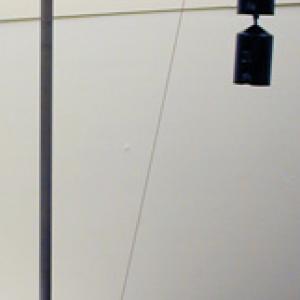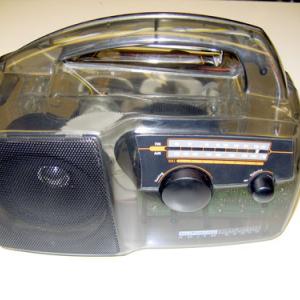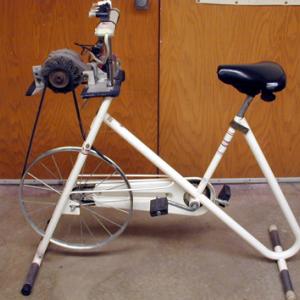College of Liberal Arts & Sciences
5K40.85 - Energy Conversion Demos
Video Credit: Jonathan M. Sullivan-Wood.
Setup is as indicated. Be sure generator is clamped and that the string on the generator is in good shape as it must hold at least 6 Kg for a long time. Once set up as shown a simple starting turn of the crank handle should start the demo in motion.
The radio will run by converting several different forms of energy to electricity. It has built in solar cells (sunlight to electricity), and it also has a crank that can be used to wind a coil spring that will power an internal generator for several minutes (mechanical energy to electricity).
The peddle generator is set to have an output of 100 watts. Approximately 70 watts of power is used for the light bulbs, with the other 30 watts used to energize the alternator field coil. Since we are using an alternator we also need a 6 volt battery to energize the coil at startup. Once the field coil is energized the battery is taken out of the circuit. 100 watts is approximately the average output of the human body.
- Jules Greenberg, "Quantitative Data from a Magneto Electric Generator", TPT, Vol. 13, # 4, Apr. 1975, p. 247.
- Jay S. Huebner, "How Should Physicists, Biologists Work Together? The Harness the Hubris Debate Continues", Physics Today, December 1997.
- Martin C. Sagendorf, "Energy Conversions", Physics Demonstration Apparatus, 2009, p. 29.
- John L. Roeder, Actiivity 5, "Power of a Student", Teaching About Energy, p. 78.
- Cash, Parker, and Taylor, 175 More Science Experiments, p. 58 - 59.
- Ron Hipschman, "Pedal Generator", Exploratorium Cookbook III, 150.1 - 150.3.
Disclaimer: These demonstrations are provided only for illustrative use by persons affiliated with The University of Iowa and only under the direction of a trained instructor or physicist. The University of Iowa is not responsible for demonstrations performed by those using their own equipment or who choose to use this reference material for their own purpose. The demonstrations included here are within the public domain and can be found in materials contained in libraries, bookstores, and through electronic sources. Performing all or any portion of any of these demonstrations, with or without revisions not depicted here entails inherent risks. These risks include, without limitation, bodily injury (and possibly death), including risks to health that may be temporary or permanent and that may exacerbate a pre-existing medical condition; and property loss or damage. Anyone performing any part of these demonstrations, even with revisions, knowingly and voluntarily assumes all risks associated with them.


